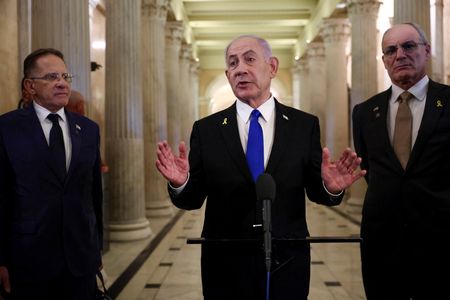(Reuters) – Britain and the United States trade hundreds of billions of dollars’ worth of goods and services annually, but London hopes that ambiguities in the data will help to earn it an exclusion from U.S. President Donald Trump’s sweeping tariff plans.
Unusually, both countries report trade surpluses with each other owing to differences in the way they measure trade – something that British Prime Minister Keir Starmer hopes will work to his advantage.
Trump said on Sunday that he thought something could be “worked out” with Britain on the threat of tariffs.
Here are the facts and figures on trade between Britain and the United States.
HOW MUCH DO THE UK AND US TRADE?
Imports and exports of goods and services between Britain and the U.S. totalled $317 billion in 2023, according to the U.S. Bureau of Economic Analysis (BEA), which puts Britain in fifth place as a U.S. trade partner after Canada, Mexico, China and Germany.
The United States is Britain’s single biggest national trade partner, although the UK trades far more with the 27 members of the European Union as a bloc.
WHAT DO THEY TRADE?
British data show services now account for the bulk of the UK’s transatlantic trade. Services fall outside of the kind of tariffs that Trump is planning to exact on goods trade with other countries.
Britain’s Office for National Statistics (ONS) says “other business services” – which includes the professional services industry such as accountants and law firms – are Britain’s top export to the U.S., far outweighing sales of capital goods.
The U.S. BEA paints a very different picture. It says capital goods, excluding cars, are the United States’ top import from Britain.
Differences in the way the two statistics agencies measure trade help explain the discrepancy, known by statisticians as asymmetries.
HOW CAN THE UK AND US BOTH REPORT TRADE SURPLUSES?
Britain reported a 71.1 billion-pound trade surplus with the U.S. in the year to the third quarter of 2024, while the BEA says the U.S. had a $15.1 billion surplus over the same period.
Both countries adhere to the latest International Monetary Fund standards for measuring trade, but the ONS said last month that the two statistics agencies were implementing them at different speeds.
That affects the measurement of services trade especially, where small differences in definitions can produce big differences in the data.
For instance, in 2020 the ONS said differences in the way it measures financial market trades and services offered by financial institutions contributed to an identifiable 10 billion-pound gap with the BEA data.
“The measurement of trade flows and relationships are complex. This means asymmetries are an inevitable consequence and can affect all data compilers,” the ONS said last month.
WHAT ARE THE POLITICS?
Trump said on Sunday that although Britain was “out of line” when it came to trade he thought it may be able to avoid tariffs, adding of the imbalance: “I think that one can be worked out”. He added that Starmer had been “very nice”.
Last month British finance minister Rachel Reeves stressed that Britain runs a trade deficit with the United States, at odds with the findings of the ONS.
The BEA data show that the U.S. runs a trade surplus for both goods and services. ($1 = 0.8100 pounds)
(Reporting by Andy Bruce; Editing by Hugh Lawson)








